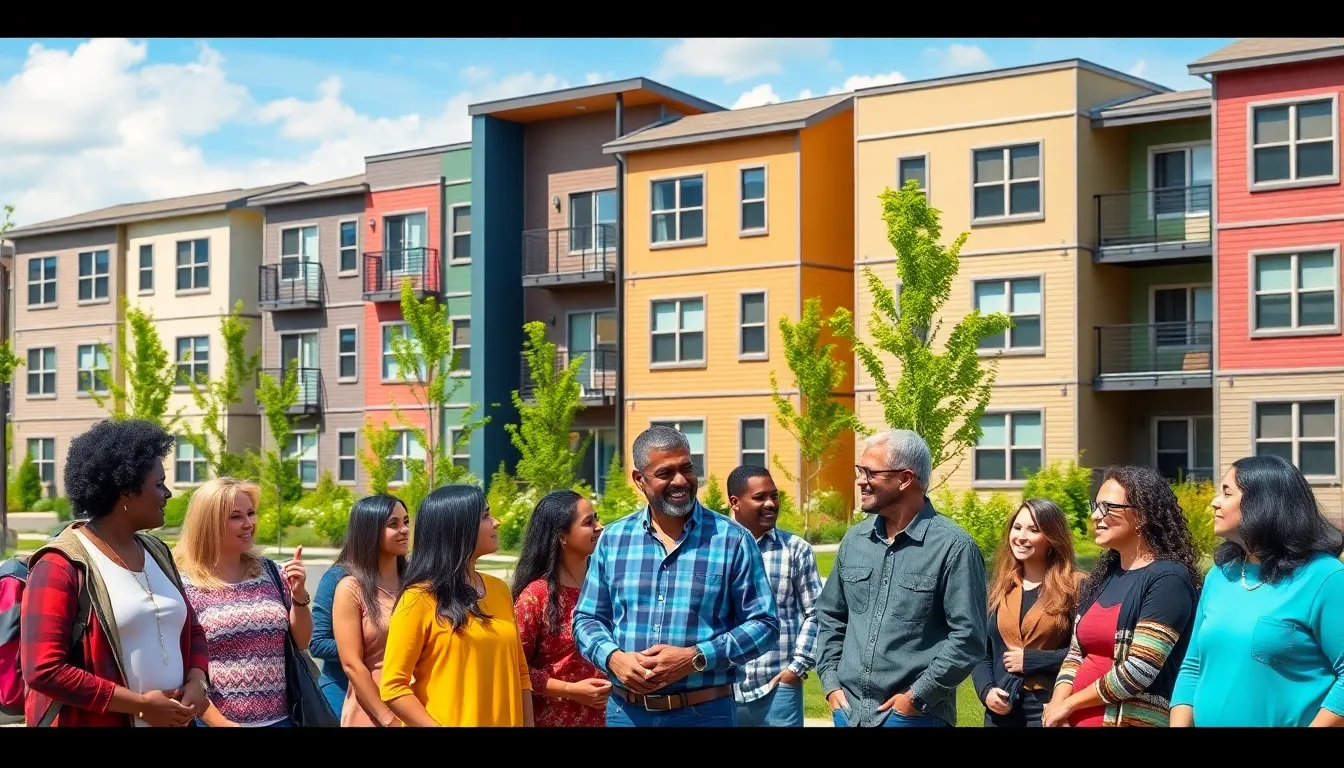In today’s rapidly changing economic landscape, the need for affordable housing has never been more pressing. Rising costs and stagnant wages are pushing many families to the brink, making it essential for communities to explore innovative housing initiatives. These programs aim to provide safe and accessible homes for everyone, regardless of income.
Affordable housing initiatives not only address the immediate needs of low-income families but also contribute to the overall health of communities. By fostering stability and reducing homelessness, these projects create environments where individuals can thrive. As cities across the nation adopt various strategies, understanding the impact and effectiveness of these initiatives becomes crucial for driving meaningful change.
Table of Contents
ToggleOverview of Affordable Housing Initiatives
Affordable housing initiatives focus on creating and maintaining housing options that are financially accessible for low to moderate-income individuals and families. Various programs exist, with some relying on public funding, while others harness private investment.
Types of Affordable Housing Initiatives
- Public Housing: Governed by local housing authorities, public housing provides rental units for eligible low-income residents. Rent is often based on income, ensuring affordability.
- Housing Choice Vouchers: Formerly known as Section 8, this program helps families pay for rental homes in the private market, allowing greater flexibility in housing choices.
- Inclusionary Zoning: Local laws require developers to set aside a percentage of units in new developments for low-income residents, integrating affordable housing within market-rate projects.
- Community Land Trusts: Nonprofit organizations acquire and hold land, developing affordable housing while ensuring long-term affordability through ground leases.
Key Benefits of Affordable Housing Initiatives
- Stability: Safe housing contributes to family stability, which enhances educational performance for children and promotes overall community health.
- Economic Growth: Providing affordable housing generates local jobs and stimulates economic activity in underserved areas.
- Reduced Homelessness: Initiatives targeting affordability help prevent homelessness by ensuring low-income families have access to stable living conditions.
- Diverse Communities: Affordable housing initiatives foster mixed-income neighborhoods, promoting social inclusivity and reducing socioeconomic disparities.
Challenges Faced by Affordable Housing Initiatives
- Funding Constraints: Limited public funding sources challenge the expansion and sustainability of affordable housing projects.
- NIMBYism: Community opposition can create barriers to new developments, complicating efforts to increase affordable housing stock.
- Regulatory Hurdles: Zoning laws and building regulations may restrict development potential, slowing down initiative implementation.
Affordable housing initiatives play a crucial role in addressing the housing crisis, benefiting individuals and the broader community.
Types of Affordable Housing Initiatives

Various affordable housing initiatives exist to tackle housing challenges across communities. These initiatives include government programs, non-profit organizations, and public-private partnerships, each contributing uniquely to the creation of affordable housing.
Government Programs
Government programs provide financial assistance and regulatory support to enhance affordable housing availability. Programs like the Low-Income Housing Tax Credit (LIHTC) incentivize private developers to build affordable units by offering tax benefits. Additionally, federal funds for public housing assist low-income families through subsidized rent. Local governments often utilize zoning laws to facilitate the construction of affordable housing, ensuring that new developments align with community needs.
Non-Profit Organizations
Non-profit organizations play a vital role in advocating for affordable housing and providing resources to underserved populations. Organizations such as Habitat for Humanity focus on building homes with the help of volunteers and low-interest loans for qualifying families. Many non-profits also offer housing counseling services to guide families through the rental or buying process, improving access to affordable housing options. Collaborations between non-profits and community stakeholders help leverage resources and increase housing availability.
Public-Private Partnerships
Public-private partnerships (PPPs) leverage resources from both sectors to develop affordable housing solutions. These partnerships often involve local governments and private developers working together to design and build housing projects that meet community needs. PPPs can secure funding through tax incentives, grants, and private investments, effectively expanding the pool of affordable housing. Successful examples of these partnerships illustrate their ability to tackle complex housing issues while fostering economic development in surrounding areas.
Successful Case Studies
Successful affordable housing initiatives demonstrate effective strategies in urban and rural settings. These case studies highlight innovative approaches that deliver tangible results.
Urban Areas
In urban areas, the New York City Department of Housing Preservation and Development utilizes the Housing New York plan. This comprehensive initiative aims to create and preserve 300,000 affordable housing units by 2026. Core strategies include investing in public-private partnerships, increasing zoning allowances, and promoting mixed-income developments. Additionally, the Los Angeles Housing Authority introduced the Homekey project, transforming hotels and motels into permanent supportive housing. This initiative has successfully housed over 12,000 individuals experiencing homelessness.
Rural Areas
In rural contexts, the USDA Rural Development’s Community Facilities Program focuses on building affordable housing in underserved areas. The program has financed over $3 billion in loans and grants since 2010, assisting thousands of low-income families. Moreover, the Rural Voices for Conservation Coalition partners with local non-profits to develop affordable housing while preserving environmental integrity. Their initiatives, such as the Alliance for the San Juans, have fostered sustainable, affordable communities in rural landscapes by integrating ecological considerations with housing development.
Challenges Faced by Affordable Housing Initiatives
Affordable housing initiatives encounter several significant challenges that can hinder their effectiveness and reach.
Funding Issues
Funding issues present a major obstacle for affordable housing initiatives. Limited financial resources constrict the ability to develop and maintain housing options for low-income families. According to the National Low Income Housing Coalition, the United States faces a shortage of 7 million affordable rental homes for extremely low-income renters. Many programs rely on government funding, grants, and donations, which can fluctuate with political priorities and economic conditions. Additionally, high construction costs further strain budgets, making it difficult to deliver housing solutions at a price point that remains accessible for low-income residents.
Community Resistance
Community resistance, often referred to as NIMBYism (Not In My Backyard), poses a significant challenge to affordable housing initiatives. Local residents frequently express concerns about property values, increased traffic, and neighborhood changes. These objections can lead to delays in approvals and influence zoning regulations, making it harder to implement projects. A report from the Urban Institute indicates that community opposition can significantly stymie development timelines and increase costs. Effective communication and stakeholder engagement strategies are essential to mitigate these concerns and foster acceptance of affordable housing within communities.
Future of Affordable Housing Initiatives
Innovative strategies continue to shape the future of affordable housing initiatives. Cities increasingly prioritize sustainability by incorporating green building practices in new developments. Energy-efficient designs reduce long-term utility costs for residents, contributing to economic stability.
Technological advancements play a significant role in enhancing housing initiatives. Smart technology can improve housing management through efficient resource tracking and maintenance alerts. Moreover, digital platforms can streamline application processes for housing assistance, making these resources more accessible.
Public-private partnerships are expected to expand, allowing diverse funding sources to tackle housing shortages. Collaboration between governments and private developers fosters innovative project designs while sharing the financial burden of construction and maintenance.
Community engagement remains critical for successful initiatives. Local governments can host forums to gather input and adapt projects to meet community needs. Empowering residents to participate in the planning process promotes transparency and can mitigate opposition, ensuring smoother project implementation.
Legislative changes may affect the landscape of affordable housing. Policies aimed at increasing funding for housing programs or incentivizing developers to build affordable units can have a lasting impact. Continued advocacy for housing rights can lead to stronger protections and support for vulnerable populations.
Data-driven approaches help measure the effectiveness of current initiatives. By analyzing metrics such as housing stability and integration levels, stakeholders can refine strategies and allocate resources more efficiently. Utilizing research findings enables communities to create targeted solutions that address specific housing barriers.
Flexible zoning regulations will play a crucial role. Allowing increased density in urban areas can facilitate more affordable housing units and create vibrant communities. Policies that eliminate restrictive zoning laws can drive the development of diverse housing options, enhancing availability for low-income residents.
Collaboration with non-profit organizations will become increasingly important. These organizations often possess deep community ties and can leverage local knowledge to identify housing needs. By strengthening partnerships, cities can create sustainable solutions that effectively address affordability challenges.
Overall, the future of affordable housing initiatives hinges on innovation, collaboration, and community engagement. Through thoughtful strategies, the impact of these initiatives can significantly improve housing accessibility for families across various income levels.
Affordable housing initiatives are crucial for addressing the pressing needs of families facing economic challenges. By fostering collaboration among government entities non-profits and private sectors these programs can create lasting impacts on communities. The focus on innovative strategies and community engagement ensures that diverse housing options remain accessible to all income levels.
As cities continue to explore and implement various approaches the importance of overcoming funding and regulatory hurdles cannot be overstated. The future of affordable housing depends on the commitment to sustainable practices and the willingness to adapt to changing needs. Ultimately these initiatives hold the potential to transform lives and build stronger healthier communities.



